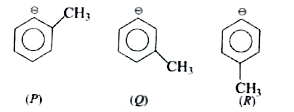Which of the following stability order of anions is/are correct :



ӨCH3I>ӨCD3II I>II
The correct Answer is:A, B, C, D
To determine the stability order of anions, we need to analyze the effects of different substituents on the stability of the negative charge. Here’s a step-by-step solution to the question:
Step 1: Understand the Factors Affecting Anion Stability
- Anion stability is influenced by factors such as electronegativity, resonance, inductive effects, and the ability of substituents to stabilize the negative charge.
- Electron-withdrawing groups (EWGs) stabilize anions by dispersing the negative charge, while electron-donating groups (EDGs) destabilize them.
Step 2: Analyze Each Option
1. Option A: Cl, NO2, CN
- NO2 (nitro group) is a strong electron-withdrawing group due to both -I (inductive) and -M (mesomeric) effects, making it the most stabilizing for the anion.
- CN (cyano group) is also an electron-withdrawing group but less effective than NO2.
- Cl (chlorine) is a weak -I group and does not stabilize the anion as effectively as NO2 and CN.
- Stability Order: NO2 > CN > Cl
2. Option B: Carbocations
- The stability of carbocations increases with the number of alkyl groups attached (hyperconjugation).
- The presence of electron-withdrawing groups can also stabilize carbocations by resonance.
- Analyze the structures provided to determine which carbocation is more stable based on resonance and inductive effects.
- Stability Order: Depends on the specific structures given.
3. Option C: Resonance Structures
- More resonance structures generally lead to greater stability of the anion.
- Compare the number of resonance structures for each anion to determine their stability.
- Stability Order: More resonance structures > fewer resonance structures.
4. Option D: CH3- and C-
- The presence of alkyl groups (like CH3) can stabilize negative charges through hyperconjugation.
- Compare the stability of CH3- (methyl anion) and C- (carbanion) based on their ability to stabilize the negative charge.
- Stability Order: CH3- > C- due to the stabilizing effect of the alkyl group.
Conclusion
After analyzing all options, we can conclude that:
- The stability orders derived from the analysis are correct.
- Therefore, all options (A, B, C, D) are valid stability orders for the anions.
Final Stability Order Summary
- Option A: NO2 > CN > Cl
- Option B: (depends on specific structures)
- Option C: (depends on specific structures)
- Option D: CH3- > C-
- Anion stability is influenced by factors such as electronegativity, resonance, inductive effects, and the ability of substituents to stabilize the negative charge.
- Electron-withdrawing groups (EWGs) stabilize anions by dispersing the negative charge, while electron-donating groups (EDGs) destabilize them.
1. Option A: Cl, NO2, CN
- NO2 (nitro group) is a strong electron-withdrawing group due to both -I (inductive) and -M (mesomeric) effects, making it the most stabilizing for the anion.
- CN (cyano group) is also an electron-withdrawing group but less effective than NO2.
- Cl (chlorine) is a weak -I group and does not stabilize the anion as effectively as NO2 and CN.
- Stability Order: NO2 > CN > Cl
- The stability of carbocations increases with the number of alkyl groups attached (hyperconjugation).
- The presence of electron-withdrawing groups can also stabilize carbocations by resonance.
- Analyze the structures provided to determine which carbocation is more stable based on resonance and inductive effects.
- Stability Order: Depends on the specific structures given.
- More resonance structures generally lead to greater stability of the anion.
- Compare the number of resonance structures for each anion to determine their stability.
- Stability Order: More resonance structures > fewer resonance structures.
- The presence of alkyl groups (like CH3) can stabilize negative charges through hyperconjugation.
- Compare the stability of CH3- (methyl anion) and C- (carbanion) based on their ability to stabilize the negative charge.
- Stability Order: CH3- > C- due to the stabilizing effect of the alkyl group.
After analyzing all options, we can conclude that:
- The stability orders derived from the analysis are correct.
- Therefore, all options (A, B, C, D) are valid stability orders for the anions.
- Option A: NO2 > CN > Cl
- Option B: (depends on specific structures)
- Option C: (depends on specific structures)
- Option D: CH3- > C-
Topper's Solved these Questions
- GENERAL ORGANIC CHEMISTRY IIBOOK - RESONANCE ENGLISHCHAPTER - GENERAL ORGANIC CHEMISTRY IIEXERCISE - Part-IV : Comprehension
12 Videos
- GENERAL ORGANIC CHEMISTRY IIBOOK - RESONANCE ENGLISHCHAPTER - GENERAL ORGANIC CHEMISTRY IIEXERCISE - Exercise-3 Part:I JEE(Advanced)/IIT-JEE Problems (Previous Years)
17 Videos
- GENERAL ORGANIC CHEMISTRY IIBOOK - RESONANCE ENGLISHCHAPTER - GENERAL ORGANIC CHEMISTRY IIEXERCISE - Part-II: Single And Double Value Integer Type
9 Videos
- GASEOUS STATEBOOK - RESONANCE ENGLISHCHAPTER - GASEOUS STATEEXERCISE - ORGANIC CHEMISTRY(Hydrocarbon)
18 Videos
- GENERAL ORGANIC CHEMISTRY-IBOOK - RESONANCE ENGLISHCHAPTER - GENERAL ORGANIC CHEMISTRY-IEXERCISE - PART-III : PRACTICE TEST-19
1 Videos
Similar Questions
Knowledge Check
Which of the following is correct order of stability of alkene?
A B
B C
C D
D
Increasing order of the following stability is :
 AI>II>III>IVBI>III>II>IVCI>IV>III>IIDIV>III>II>I
AI>II>III>IVBI>III>II>IVCI>IV>III>IIDIV>III>II>IWhich of the following orders is correct ordre of these anions?
 AQ>R>PBQ>P>RCR>Q>PDP>Q>R
AQ>R>PBQ>P>RCR>Q>PDP>Q>R
Stability order of given anions is :

View SolutionWhich of the following is correct order of stability:
View SolutionWhich of the following is the correct order of stability of free radicals ?
View SolutionWhich of the following is the correct order of stability of the
following compounds ?
View SolutionWhich of the following orders are correct regarding stability?
View Solution
